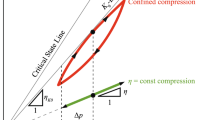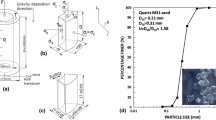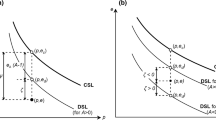Abstract
This paper attempts to clarify the necessary elements for describing the non-coaxial behavior of sand in the plasticity framework based on the critical-state soil mechanics. Such sand response to two representative loading types, the monotonic loading with fixed principal stress direction and rotation of principal stress direction, is the main focus. The present constitutive model can be regarded as an extension of the existing platform model for sand considering the inherent anisotropy. A novel non-coaxial flow direction involved in the plastic flow rule is the crucial feature, which is defined as the part of stress increment perpendicular to a reference direction related to the current stress direction through the Gram–Schmidt orthogonalization process. Such incorporation of the effects of the stress increment on the plastic deformation makes the model capture the non-coaxiality for the monotonic loading with fixed principal stress direction. In order to describe the plastic response induced by the pure rotation of principal stress direction, a set of map** rules included in the bounding surface plasticity are formulated to develop plastic flow mechanism in the general multi-axial stress space. Besides, the effects of fabric anisotropy on simulating the non-coaxial plastic behavior are discussed. The results show that the above-mentioned modifications on these model ingredients make the theoretical simulation fit well with test data for Toyoura sand under the foregoing two loading conditions.













Similar content being viewed by others
Abbreviations
- A :
-
Anisotropic variable
- b :
-
Intermediate principal stress ratio
- e, ec :
-
Void ratio and critical-state void ratio
- f, F :
-
Yield surface and bounding surface
- G :
-
Elastic shear modulus
- g(θ):
-
Interpolation function for the failure stress ratio
- K :
-
Elastic bulk modulus
- HL, HU :
-
Loading plastic modulus and unloading plastic modulus
- M :
-
Internal state variable related to stress history
- Mc, Me :
-
Critical-state stress ratio in triaxial compression and triaxial extension
- Md, Mp :
-
Phase transformation stress ratio and peak stress ratio
- n ij :
-
Loading direction defined in the yield surface
- \(\bar{n}_{ij}\) :
-
Loading direction defined in the bounding surface
- \(n_{ij}^{g}\) :
-
Integrated plastic flow direction
- \(n_{ij}^{gc}\), \(n_{ij}^{gn}\) :
-
Coaxial part and non-coaxial part of the integrated plastic flow direction
- \(n_{p}^{g}\), \(n_{q}^{g}\), \(n_{\theta }^{g}\) :
-
Three components related to the first derivatives of p, q and θ in \(n_{ij}^{gc}\)
- \(n_{ij}^{{{\text{d}}\sigma }}\) :
-
Normalized unit tensor of stress increment tensor
- \(n_{ij}^{\text{non}}\) :
-
Non-coaxial flow direction
- \(\hat{R}\) :
-
Stress ratio related to a modified stress
- R1, R2 :
-
Similarity ratio related to radial map** and stress rate direction map**
- p, \(\bar{p}\) :
-
Mean pressure related to current stress and image stress
- q, \(\bar{q}\) :
-
Equivalent stress related to current stress and image stress
- s ij :
-
Deviatoric stress tensor and image deviatoric stress tensor
- dsij :
-
Deviatoric part of stress increment \({\text{d}}\sigma_{ij}\)
- \({\text{d}}s_{ij}^{\text{non}}\) :
-
Component of dsij along the direction orthogonal to sij
- \(s_{ij}^{p}\) :
-
Principal stress tensor of sij
- \(S_{ij}^{p}\) :
-
Combined stress tensor related to \(s_{ij}^{p}\)
- \(\hat{T}_{ij}\) :
-
Modified stress tensor
- \(\alpha\) :
-
Angle of the major principal stress in relation to orientation of deposition
- \(\beta\) :
-
Angle of the major principal plastic strain increment to the vertical axis
- \(\delta_{ij}\) :
-
Kronecker delta
- \(\Delta\) :
-
Vector magnitude characterizing the fabric anisotropy
- \(\varepsilon_{ij}\), \(\varepsilon_{ij}^{e}\), \(\varepsilon_{ij}^{p}\) :
-
Strain tensor, elastic strain tensor and plastic strain tensor
- \(\varepsilon_{ij}^{pc}\), \(\varepsilon_{ij}^{pn}\) :
-
Coaxial plastic strain tensor and non-coaxial plastic strain tensor
- \(\varepsilon_{z}\), \(\varepsilon_{r}\), \(\varepsilon_{\vartheta }\), \(\varepsilon_{z\vartheta }\) :
-
Axial, radial, circumferential and torsional strains
- \(\theta\), \(\bar{\theta }\), \(\hat{\theta }\) :
-
Lode angle related to current stress, image stress and modified stress
- \(\sigma_{ij}\), \(\bar{\sigma }_{ij}\) :
-
Current stress tensor, image stress tensor
- \(\bar{\sigma }_{ij}^{1}\), \(\bar{\sigma }_{ij}^{2}\) :
-
Radial map** and stress rate direction map**
- \(\sigma_{1}\), \(\sigma_{2}\), \(\sigma_{3}\) :
-
Major, intermediate and minor principal stresses
- \(\sigma_{z}\), \(\sigma_{r}\), \(\sigma_{\vartheta }\), \(\tau_{z\vartheta }\) :
-
Axial, radial, circumferential and torsional stresses
- \(\psi\) :
-
State parameter
- \(\omega_{ij}\) :
-
Projection center related to radial map**
- \(\sigma_{ij} = \left[ {\sigma_{11} \sigma_{33} \sigma_{13} } \right]\left( {i,j = 1,2} \right)\) :
-
Map** from tensor to vector in stress space (\(\sigma_{11}\), \(\sigma_{33}\), \(\sigma_{13}\))
- \(t_{ij}^{\text{non}} \left( {i,j = 1,2} \right)\) :
-
Direction of current stress in stress space (\(\sigma_{11}\), \(\sigma_{33}\), \(\sigma_{13}\))
- \(m_{ij} \left( {{\text{i}},{\text{j}} = 1,2} \right)\) :
-
Direction orthogonal to current stress in stress space (\(\sigma_{11}\), \(\sigma_{33}\), \(\sigma_{13}\))
- \(m_{ij}^{\text{non}} \left( {i,j = 1,2} \right)\) :
-
Non-coaxial flow related to \(m_{ij}\)
References
Arthur JRF, Chua KS, Dunstan T (1977) Induced anisotropy in a sand. Geotechnique 27(1):13–30
Bee K, Jefferies MG (1985) A state parameter for sand. Geotechnique 35(2):99–112
Cai Y, Yu HS, Wanatowski D, Li X (2012) Noncoaxial behavior of sand under various stress paths. J Geotech Geoenviron Eng 139(8):1381–1395
Dafalias YF, Popov EP (1977) Cyclic loading for materials with a vanishing elastic region. Nucl Eng Des 41(2):293–302
Josselin De, de Jong G (1971) The double sliding, free rotating model for granular assemblies. Geotechnique 21(2):155–163
Drucker DC, Prager W (1952) Soil mechanics and plastic analysis or limit design. Q Appl Math 10(2):157–165
Fukushima S, Tatsuoka F (1984) Strength and deformation characteristics of saturated sand at extremely low pressures. Soils Found 24(4):30–48
Gutierrez M, Ishihara K, Towhata I (1991) Flow theory for sand during rotation of principal stress direction. Soils Found 31(4):121–132
Hashiguchi K (1989) Subloading surface model in unconventional plasticity. Int J Solids Struct 25(8):917–945
Hashiguchi K, Tsutsumi S (2001) Elastoplastic constitutive equation with tangential stress rate effect. Int J Plast 17(1):117–145
Hight DW, Gens A, Symes MJ (1983) The development of a new hollow cylinder apparatus for investigating the effects of principal stress rotation in soils. Geotechnique 33(4):355–383
Huang M, Lu X, Qian J (2010) Non-coaxial elasto-plasticity model and bifurcation prediction of shear banding in sands. Int J Numer Anal Meth Geomech 34(9):906–919
Huang MS, Chen ZQ, Lu XL (2018) Bifurcation prediction of shear banding in sand with a non-coaxial critical state model considering inherent anisotropy. Soils Found 58(3):641–653
Ishihara K, Towhata I (1983) Sand response to cyclic rotation of principal stress directions as induced by wave loads. Soils Found 23(4):11–26
Ishihara K (1993) Liquefaction and flow failure during earthquakes. Géotechnique 43(3):351–415
Lam WK, Tatsuoka F (1988) Effects of initial anisotropic fabric and σ2 on strength and deformation characteristics of sand. Soils Found 28(1):89–106
Lashkari A, Latifi M (2008) A non-coaxial constitutive model for sand deformation under rotation of principal stress axes. Int J Numer Anal Methods Geomech 32(9):1051–1086
Li XS, Dafalias YF (2000) Dilatancy for cohesionless soils. Geotechnique 50(4):449–460
Li XS, Dafalias YF (2002) Constitutive modeling of inherently anisotropic sand behavior. J Geotech Geoenviron Eng 128(10):868–880
Li XS, Dafalias YF (2004) A constitutive framework for anisotropic sand including non-proportional loading. Geotechnique 54(1):41–55
Lu XL, Huang MS (2015) Static liquefaction of sands under isotropically and Ko-consolidated undrained triaxial conditions. J Geotech Geoenviron Eng 141(1):04014087
Lu XL, Huang MS, Qian JG (2011) The onset of strain localization in cross-anisotropic soils under true triaxial condition. Soils Found 51(4):693–700
Miura K, Miura S, Toki S (1986) Deformation behavior of anisotropic dense sand under principal stress axes rotation. Soils Found 26(1):36–52
Nicot F, Darve F (2007) Basic features of plastic strains: from micro-mechanics to incrementally nonlinear models. Int J Plast 23:1555–1588
Oda M, Koishikawa I, Higuchi T (1978) Experimental study of anisotropic shear strength of sand by plane strain test. Soils Found 18(1):25–38
Pastor M, Zienkiewicz OC, Chan AHC (1990) Generalized plasticity and the modelling of soil behaviour. Int J Numer Anal Methods Geomech 14(3):151–190
Papamichos E, Vardoulakis I (1995) Shear band formation in sand according to non-coaxial plasticity model. Geotechnique 45(4):649–661
Papadimitriou AG, Bouckovalas GD (2002) Plasticity model for sand under small and large cyclic strains: a multiaxial formulation. Soil Dyn Earthq Eng 22(3):191–204
Pradel D, Ishihara K, Gutierrez M (1990) Yielding and flow of sand under principal stress axes rotation. Soils Found 30(1):87–99
Qian JG, Yang J, Huang MS (2008) Three-dimensional noncoaxial plasticity modeling of shear band formation in geomaterials. J Eng Mech 134(4):322–329
Richart FE Jr, Hall JR, Woods RD (1970) Vibration of soils and foundations. Prentice-Hall, Englewood Cliffs
Roscoe KH, Bassett RH, Cole ER (1967) Principal axes observed during simple shear of a sand. In: Proceedings of the geotechnical conference, vol 1, pp 231–237. Oslo
Roscoe KH (1970) The influence of strains in soil mechanics. Geotechnique 20(2):129–170
Rudnick JW, Rice JR (1975) Conditions for the localization of deformation in pressure-sensitive dilatant materials. J Mech Phys Solids 23(6):371–394
Spencer AJM (1964) A theory of the kinematics of ideal soils under plane strain conditions. J Mech Phys Solids 12(5):337–351
Tatsuoka F, Sakamoto M, Kawamura T, Fukushima S (1986) Strength and deformation characteristics of sand in plane strain compression at extremely low pressures. Soils Found 26(1):65–84
Tian Y, Yao YP (2017) Modelling the non-coaxiality of soils from the view of cross-anisotropy. Comput Geotech 86:219–229
Trefethen LN, Bau D III (1997) Numerical linear algebra. Society for industrial and Applied Mathematics, Philadelphia
Tsutsumi S, Hashiguchi K (2005) General non-proportional loading behavior of soils. Int J Plast 21(10):1941–1969
Wang ZL, Dafalias YF, Shen CK (1990) Bounding surface hypoplasticity model for sand. J Eng Mech 116(5):983–1001
Yu HS, Yuan X (2006) On a class of non-coaxial plasticity models for granular soils. Proc R Soc Lond A Math Phys Eng Sci 462(2067):725–748
Yang ZX, Li XS, Yang J (2008) Quantifying and modelling fabric anisotropy of granular soils. Géotechnique 58(4):237–248
Acknowledgements
This work was financially supported by the National Natural Science Foundation of China (Grant No. 51738010) and the National Key R&D Program of China (Grant No. 2016YFC0800200).
Author information
Authors and Affiliations
Corresponding author
Additional information
Publisher's Note
Springer Nature remains neutral with regard to jurisdictional claims in published maps and institutional affiliations.
Appendices
Appendix 1
Due to \({\text{d}}s_{ij} /s_{ij} = {\text{const}}\), substituting \({\text{d}}s_{ij} = {\text{const}} \cdot s_{ij}\) into Eq. (5) yields
Due to \(S_{ij} = s_{ik} s_{kj} - \frac{2}{3}J_{2} \delta_{ij} - \frac{{3J_{3} }}{{2J_{2} }}s_{ij}\),
Considering that \(\delta_{ij} s_{ij} = 0\), \(J_{2} = \frac{1}{2}s_{ij} s_{ij}\) and \(J_{3} = \frac{1}{3}s_{ij} s_{jk} s_{ki}\), Eq. (44) can be reduced to
As a result, Eq. (7) is proved due to \(s_{ij} S_{ij} = s_{kl} S_{kl} = 0\).
Appendix 2
The corresponding partial derivatives are given as follows
Appendix 3
Given that the integrated plastic flow rule is written as
For the stress-controlled loading condition that \({\text{d}}\sigma_{ij}\) is known, Eq. (25) can be used directly to calculate the plastic loading index. For the strain-controlled loading condition that \({\text{d}}\varepsilon_{ij}\) is given, substituting Eq. (2) and Eq. (49) into Eq. (25) gives
where \(D_{ijkl}^{e}\) is the elastic stiffness tensor, expressed as
Combination of Eqs. (50) and (2) yields
where
Rights and permissions
About this article
Cite this article
Chen, Z., Huang, M. Non-coaxial behavior modeling of sands subjected to principal stress rotation. Acta Geotech. 15, 655–669 (2020). https://doi.org/10.1007/s11440-018-0760-4
Received:
Accepted:
Published:
Issue Date:
DOI: https://doi.org/10.1007/s11440-018-0760-4




